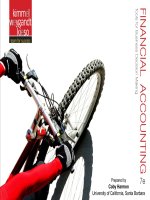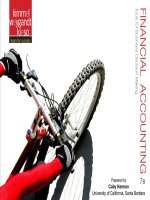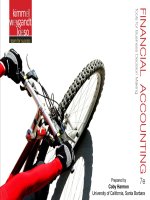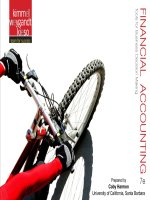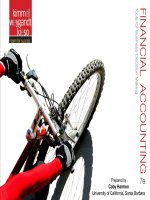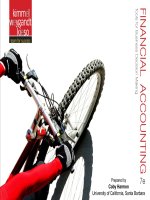Accounting tools for business decision making 7 kieo ch14
Bạn đang xem bản rút gọn của tài liệu. Xem và tải ngay bản đầy đủ của tài liệu tại đây (414.49 KB, 43 trang )
Accounting: Tools for Business
Decision Making
Seventh Edition
Kimmel; Weygandt; Kieso
Chapter 14
Managerial Accounting
Prepared by
COBY HARMON
University of California, Santa Barbara
Westmont College
This slide deck contains animations. Please disable animations if they cause issues with your device.
Chapter Outline
Learning Objectives
LO 1 Identify the features of managerial accounting and
the functions of management.
LO 2 Describe the classes of manufacturing costs and the
differences between product and period costs.
LO 3 Demonstrate how to compute cost of goods
manufactured and prepare financial statements for a
manufacturer.
LO 4 Discuss trends in managerial accounting.
Copyright ©2019 John Wiley & Sons, Inc.
2
Managerial Accounting Basics
LEARNING OBJECTIVE 1
Identify the features of managerial accounting and the
functions of management.
Provides economic and financial information for
managers and other internal users.
Comparing Managerial and Financial Accounting
Similarities and differences:
• Each field deals with economic events of a business
• Both require that economic events be quantified and
communicated to interested parties
LO 1
Copyright ©2019 John Wiley & Sons, Inc.
3
Comparing Managerial and Financial
Feature
Financial Accounting
Managerial Accounting
Primary Users
of Reports
External users: stockholders,
creditors, and regulators.
Internal users: officers and
managers.
Types and Frequency
of Reports
Financial statements.
Quarterly and annually.
Internal reports.
As frequently as needed.
Purpose of Reports
General-purpose.
Special-purpose for
specific decisions.
Content of Reports
Pertains to business as a whole.
Highly aggregated (condensed).
Limited to double-entry accounting
and cost data. Generally accepted
accounting principles.
Pertains to subunits of the
business. Very detailed.
Extends beyond double-entry
accounting to any relevant
data. Evaluated based on
relevance to decisions.
Verification Process
Audited by CPA.
No independent audits.
LO 1
Copyright ©2019 John Wiley & Sons, Inc.
4
Management Functions
Planning
Directing
• Coordinate diverse
activities and human
resources
• Implement planned
objectives
• Commit to
environmental • Provide incentives to
protection and
motivate employees
social
• Hire and train
programs
employees
• Add value to
• Produce a smooththe business
running operation
• Maximize
short-term
profit and
market share
LO 1
Copyright â2019 John Wiley & Sons, Inc.
Controlling
ã Keeping activities
on track
ã Determine whether
goals are met
• Decide changes
needed to get back
on track
• May use an informal
or formal system of
evaluations
5
Organizational Structure
Organization charts show the interrelationships of activities and the delegation of
authority and responsibility within the company.
LO 1
Copyright ©2019 John Wiley & Sons, Inc.
6
Do It! 1: Managerial Accounting
Indicate whether the following statements are true or false.
1. Managerial accountants have a single role within
an organization: collecting and reporting costs to
management.
False
2. Financial accounting reports are general-purpose
and intended for external users.
True
3. Managerial accounting reports are special-purpose
and issued as frequently as needed.
True
LO 1
Copyright ©2019 John Wiley & Sons, Inc.
7
Do It! 1: Managerial Accounting
(Continued)
Indicate whether the following statements are true or false.
4. Managers’ activities and responsibilities can be
classified into three broad functions: cost
accounting, budgeting, and internal control.
False
5. Managerial accounting reports must now
comply with generally accepted accounting
principles (GAAP).
False
LO 1
Copyright ©2019 John Wiley & Sons, Inc.
8
Managerial Cost Concepts
LEARNING OBJECTIVE 2
Describe the classes of manufacturing costs and the
differences between product and period costs.
Managers should ask questions such as the following.
1. What costs are involved in making a product or
providing a service?
2. If we decrease production volume, will costs decrease?
3. What impact will automation have on total costs?
4. How can we best control costs?
LO 2
Copyright ©2019 John Wiley & Sons, Inc.
9
Manufacturing Costs
Activities and processes that convert raw materials into
finished goods.
LO 2
Copyright ©2019 John Wiley & Sons, Inc.
10
Manufacturing Costs
Direct Materials
• Raw materials are basic materials
and parts used in manufacturing
process
• Raw materials that can be
physically and directly associated
with finished are direct materials
LO 2
Copyright ©2019 John Wiley & Sons, Inc.
11
Manufacturing Costs
Indirect Materials
Have one of two characteristics
1. Not physically part of finished product
2. Are impractical to trace to finished product because
their association with finished product is too small in
terms of cost
Considered part of manufacturing overhead
LO 2
Copyright ©2019 John Wiley & Sons, Inc.
12
Manufacturing Costs
Direct Labor and Indirect Labor
Direct Labor
Work of factory employees that
can be physically and directly
associated with converting raw
materials into finished goods.
Indirect Labor
• Work of factory employees that has no association with
finished product or
• which is impractical to trace costs to goods produced.
LO 2
Copyright ©2019 John Wiley & Sons, Inc.
13
Manufacturing Costs
Manufacturing Overhead
• Costs indirectly associated with
manufacturing the finished product
• All manufacturing costs except
direct materials and direct labor
• Also called factory overhead,
indirect manufacturing costs, or
burden
LO 2
Copyright ©2019 John Wiley & Sons, Inc.
14
Product Costs Versus Period Costs
Product Costs
• Components:
o
Direct materials
o
Direct labor
o
Manufacturing overhead
• Costs that are an integral part of producing product
• Recorded in “inventory” account
• Not an expense (COGS) until goods are sold
LO 2
Copyright ©2019 John Wiley & Sons, Inc.
15
Product Costs Versus Period Costs
Period Costs
• Charged to expense as incurred
• Non-manufacturing costs
• Includes all selling and administrative expenses
LO 2
Copyright ©2019 John Wiley & Sons, Inc.
16
Product Costs Versus Period Costs
LO 2
Copyright ©2019 John Wiley & Sons, Inc.
17
Illustration of Cost Concepts
Items 1 to 4
Illustration: Suppose you started your own snowboard factory,
Terrain Park Boards. Here are some of the costs that your
snowboard factory would incur. Assign the following costs:
LO 2
Copyright ©2019 John Wiley & Sons, Inc.
18
Illustration of Cost Concepts
Items 5 to 9
LO 2
Copyright ©2019 John Wiley & Sons, Inc.
19
Illustration of Cost Concepts
Calculation of total manufacturing costs
If Terrain Park Boards produces 10,000 snowboards the
first year, what would be the total manufacturing costs?
Cost Number and Item
1. Material cost ($30 × 10,000)
2. Labor cost ($40 × 10,000)
Manufacturing Cost
$300,000
400,000
3. Depreciation on factory equipment
25,000
4. Property taxes on factory building
6,000
7. Maintenance salaries (factory facilities)
45,000
8. Salary of plant manager
70,000
Total manufacturing costs
LO 2
$846,000
Copyright ©2019 John Wiley & Sons, Inc.
20
Do It! 2: Managerial Cost Concepts
A bicycle company has these costs: tires, salaries of employees who put
tires on the wheels, factory depreciation, advertising expenditures,
lubricants, spokes, salary of factory manager, salary of accountant,
handlebars, and salaries of factory maintenance employees. Classify each
cost as direct materials, direct labor, overhead, or a period cost.
Direct Materials
• Tires
• Spokes
• Handlebars
Direct Labor
• Salaries of
employees who put
tires on the wheels
Overhead
• Factory depreciation
• Factory lubricants
• Factory manager salary
• Factory maintenance
employees salary
Advertising expenditures and salary of accountant are period
costs.
LO 2
Copyright ©2019 John Wiley & Sons, Inc.
21
Manufacturing Costs in Financial Statements
LEARNING OBJECTIVE 3
Demonstrate how to compute cost of goods
manufactured and prepare financial statements for a
manufacturer.
Income Statement
Under a periodic inventory system, the income
statements of a merchandiser and a manufacturer differ in
the cost of goods sold section.
“COGS”
LO 3
Copyright ©2019 John Wiley & Sons, Inc.
22
Income Statement
LO 3
Copyright ©2019 John Wiley & Sons, Inc.
23
Income Statement
Cost of goods sold sections
LO 3
Copyright ©2019 John Wiley & Sons, Inc.
24
Cost of Goods Manufactured
Total Manufacturing Costs – sum of direct material costs, direct
labor costs, and manufacturing overhead in the current year.
Total Work in Process – (1) cost of beginning work in process and
(2) total manufacturing costs for the current period.
LO 3
Copyright ©2019 John Wiley & Sons, Inc.
25
